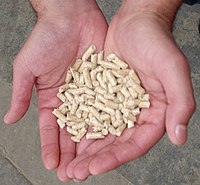
Photo from wikipedia
Abstract Rice husks ash was previously shown as a raw material for the foamed silicates production. This article is devoted to the use of the foamed silicates as an aggregate… Click to show full abstract
Abstract Rice husks ash was previously shown as a raw material for the foamed silicates production. This article is devoted to the use of the foamed silicates as an aggregate for the manufacture of lightweight cellular clay bricks. The coalescence of the foamed silicate structure inside a ceramic matrix leads to obtaining cellular lightweight ceramics in the process of firing. The present study has shown that on decreasing the ceramic brick density while using the foamed silicate filler the mechanical strength is not significantly decreased as opposed to the bricks with inert fillers. This effect is explained by obtaining a high strength glass layer on the inside surface of the cells. The lightweight cellular bricks demonstrate good heat insulation properties. Using rice husks ash as a raw for foamed granulated silicates in the manufacture of lightweight ceramic bricks not only solves the problem of rice husks as a large-tonnage waste, but also provides an environment-friendly building material with strength and heat insulation.
Journal Title: Construction and Building Materials
Year Published: 2021
Link to full text (if available)
Share on Social Media: Sign Up to like & get
recommendations!